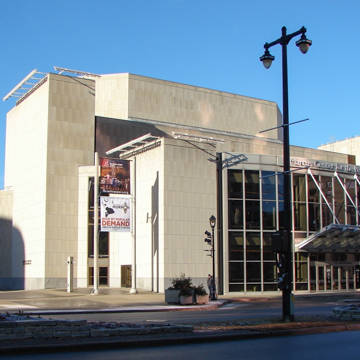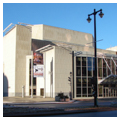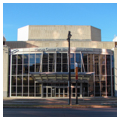The Performing Arts Center was an early step in Milwaukee’s plan to create its Riverwalk and restore cultural life to its neglected downtown. Weese’s massed geometric modernist design opens to the river, and its multilevel plaza and outdoor performance spaces are set into a chestnut grove. Above the plaza, a band of windows stretches across a stone-clad wall as the building’s cantilevered upper levels unfold to the roof. Weese’s original travertine sheathing failed after twenty years, and the building was reclad in 1994 with a lower course of pink granite topped with upper courses of limestone. An updated N. Water Street entrance design by Kahler Slater in 1996 replaced rows of columns and glass panels with a tinted window wall and suspended entrance marquee, framed by upright rectangular piers. The new entrance continues to flaunt Weese’s stacked mass of buff-colored rectangles, squares, and diamonds. Inside the 2,305-seat Uihlein Hall, redecorated by Kahler Slater in 1997, patrons find tulipwood-backed, russet seats set in brass frame rows. A circular chandelier of pendant globes reaches down from a swirl of maple planks and movable red ceiling panels that control acoustical quality.
You are here
Marcus Center for the Performing Arts
1966–1969, Harry Weese and Associates; 1994–1997 remodeled, Kahler Slater Torphy Engberg Anderson Design. 929 N. Water St.
If SAH Archipedia has been useful to you, please consider supporting it.
SAH Archipedia tells the story of the United States through its buildings, landscapes, and cities. This freely available resource empowers the public with authoritative knowledge that deepens their understanding and appreciation of the built environment. But the Society of Architectural Historians, which created SAH Archipedia with University of Virginia Press, needs your support to maintain the high-caliber research, writing, photography, cartography, editing, design, and programming that make SAH Archipedia a trusted online resource available to all who value the history of place, heritage tourism, and learning.












